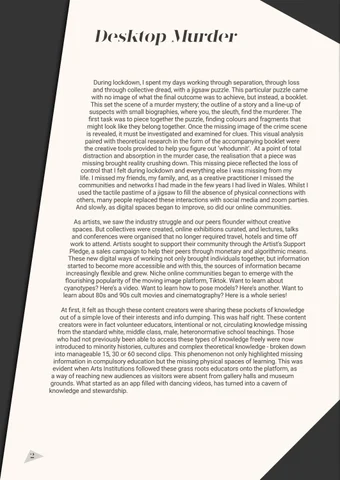Desktop Murder During lockdown, I spent my days working through separation, through loss and through collective dread, with a jigsaw puzzle. This particular puzzle came with no image of what the final outcome was to achieve, but instead, a booklet. This set the scene of a murder mystery; the outline of a story and a line-up of suspects with small biographies, where you, the sleuth, find the murderer. The first task was to piece together the puzzle, finding colours and fragments that might look like they belong together. Once the missing image of the crime scene is revealed, it must be investigated and examined for clues. This visual analysis paired with theoretical research in the form of the accompanying booklet were the creative tools provided to help you figure out ‘whodunnit’. At a point of total distraction and absorption in the murder case, the realisation that a piece was missing brought reality crushing down. This missing piece reflected the loss of control that I felt during lockdown and everything else I was missing from my life. I missed my friends, my family, and, as a creative practitioner I missed the communities and networks I had made in the few years I had lived in Wales. Whilst I used the tactile pastime of a jigsaw to fill the absence of physical connections with others, many people replaced these interactions with social media and zoom parties. And slowly, as digital spaces began to improve, so did our online communities. As artists, we saw the industry struggle and our peers flounder without creative spaces. But collectives were created, online exhibitions curated, and lectures, talks and conferences were organised that no longer required travel, hotels and time off work to attend. Artists sought to support their community through the Artist’s Support Pledge, a sales campaign to help their peers through monetary and algorithmic means. These new digital ways of working not only brought individuals together, but information started to become more accessible and with this, the sources of information became increasingly flexible and grew. Niche online communities began to emerge with the flourishing popularity of the moving image platform, Tiktok. Want to learn about cyanotypes? Here’s a video. Want to learn how to pose models? Here’s another. Want to learn about 80s and 90s cult movies and cinematography? Here is a whole series! At first, it felt as though these content creators were sharing these pockets of knowledge out of a simple love of their interests and info dumping. This was half right. These content creators were in fact volunteer educators, intentional or not, circulating knowledge missing from the standard white, middle class, male, heteronormative school teachings. Those who had not previously been able to access these types of knowledge freely were now introduced to minority histories, cultures and complex theoretical knowledge - broken down into manageable 15, 30 or 60 second clips. This phenomenon not only highlighted missing information in compulsory education but the missing physical spaces of learning. This was evident when Arts Institutions followed these grass roots educators onto the platform, as a way of reaching new audiences as visitors were absent from gallery halls and museum grounds. What started as an app filled with dancing videos, has turned into a cavern of knowledge and stewardship.
2
























